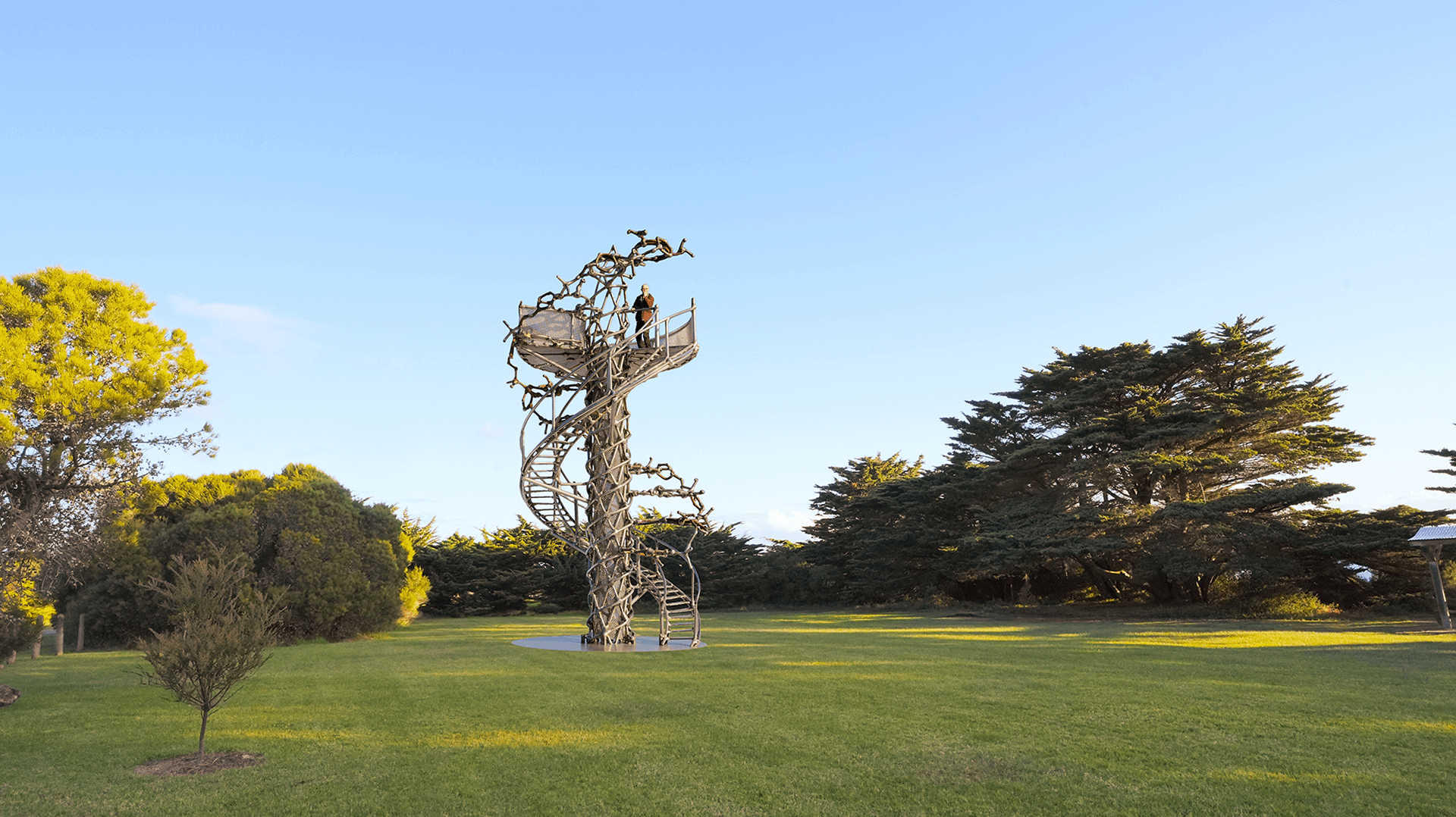San Remo
The Time Machine








Using height as a measure of time, each step you go up takes you back 2.5 million years. The polished terrazzo slab at ground level represents the present day, showing Australia and Antarctica as they are now. The elevated viewing deck, shows them joined as Gondwanaland, 125 million years ago: the time of the polar dinosaurs. The terrazzo steps and landings on the way up, hint at layers of rock, bones and sediment that have been laid down, This is what fossil hunters look for around the nearby coast.
DNA is a molecular time machine that connects us to the dinosaurs and to our mammalian ancestors. It is the only thing that connects all known life forms. The artwork’s central column, and the integral geometry, show the profound connection between DNA and the Fibonacci numbers. An integrated lighting design articulates genetic data from across all species, using programmable RGBW lights.
The polar dinosaurs of Victoria’s Bass Coast are of global, scientific significance. The diversity of dinosaurs reveals how science defines a dinosaur, how dinosaurs are related, how they are reconstructed from tiny bone fragments, and how they piece provide a picture of where dinosaurs lived and behaved. Of course, dinosaurs didn’t live alone. Fossils of an array of other animal have been discovered along the Bass Coast including turtles, the oldest and most diverse Australian mammal fossils and Koolasuchus cleelandi, the last of a group of giant amphibians – Victoria’s fossil emblem.
"As soon as I read the artist brief, I wanted to look back in time, out over the rift valley that separated Australia and Antarctica 125 million years ago."

Site Lead

A collaboration between landscape architect Kirstine Wallis and artist David Murphy, the landscape will act as a canvas for an image of DNA created using local plant species, 25 billion times larger than life. The familiar double helix will be five metres across, outlined in native grasses. Four different shrubs will represent the four molecules – A, T, G, C – that create all genetic code. Saltbush, Kangaroo Grass and others, become colours and textures in a huge image of the extraordinary molecular time machine that connects humanity to the dinosaurs – DNA.

Five plinths, each dedicated to a different dinosaur or extinct animal, will be set amongst the DNA-inspired landscape. More like ground-based terrazzo paintings, ‘the herd’ will be one step above path- level and edged in corten, showing a life-sized outline of each of these extinct animals. Each animal carries bronze replicas of the fossils palaeontologists used to identify the animal. These bronze fossils are fixed in their anatomically correct positions, highlighting the science of palaeontology, and these animals are defined and reconstructed.

Nearby, bronze sculptures will show what palaeontologists believe they may looked. Using the latest knowledge and research from the most qualified scientists in the country, combined with 3D modelling techniques, each sculpture will be the most accurate, life-like, small-scale representation possible.

In most cases, palaeontologist don't know exactly what polar dinosaurs looked like. They use comparisons with modern animals to reconstruct dinosaurs and other extinct animals. Visitors will be invited to imagine for themselves what these animals may have looked like, adding their own creative flair to life-sized, augmented-reality versions of each animal. Once reconstructed, visitors will be able to interact and take selfies with their creations. A combination of augmented reality, objects and images; ‘the herd’ will be a true melding of art and science.

Polar dinosaurs lived with a diverse range of plant and animals. In fact, an incredible array of fossils have been discovered along the Bass Coast including invertebrates, turtles, the oldest and most diverse Australian mammal fossils, and Koolasuchus cleelandi, the last of a group of giant amphibians – Victoria’s fossil emblem. Fossils continue to be discovered today, who know what will be discovered next!
Temnospondyl amphibian - Carnivore
Visitor Spending Per Year
Full Time Jobs Supported
Economic Boost During Construction
Design, installation and delivery of landscaping, dinosaur plinths and bronze dinosaur sculptures. To include:
Design development of landscape, sculptures and plinths, including site visits, documentation and modelling – 10 wks
Modelling of dinosaur sculptures and mould preparation for fossils – 12 wks
Plinth preparation and construction of terrazzo elements – 6 wks
Pouring of bronzes and cleaning up/patina etc. – 2 wks
Landscape construction with follow up watering etc. – 4 wks
Pouring concrete bases and terrazzo application on site – 2 wks
Fossils and bronze sculptures installed, landscaping finished – 2 wks
Implementation of digital experience in conjunction with dinosaur plinths – 4 wks
Design, engineering, documentation and compliance of the Time Machine – 20 weeks
Time Machine costings/quotes from fully documented and engineered design
Fabrication of the Time Machine – 40 weeks
Installation of the Time Machine – 4 weeks
Commissioning of lighting and digital programming – 2 weeks
